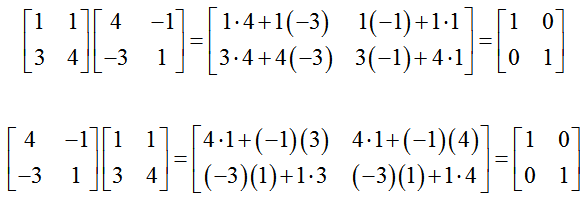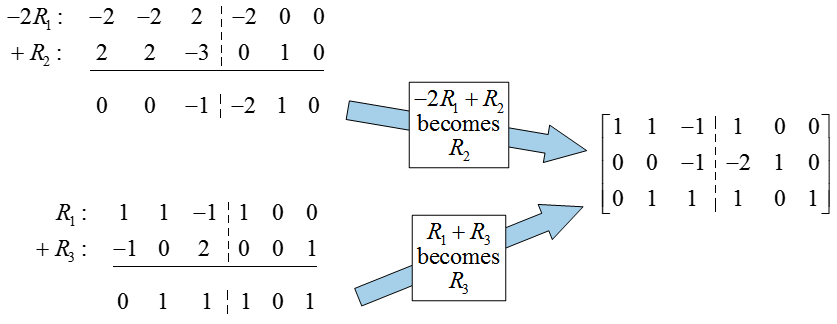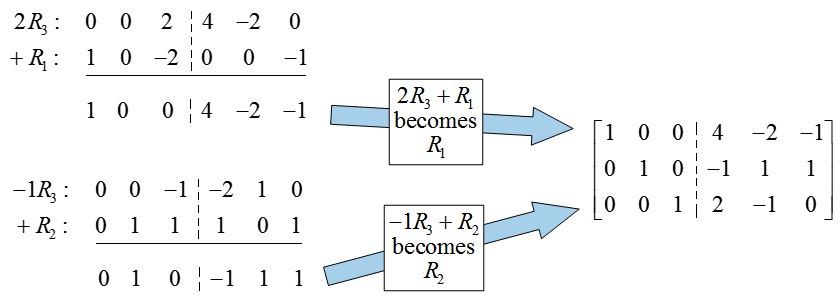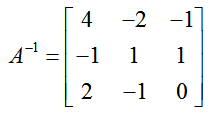How do you find a matrix inverse?
In the previous question, we learned how to check whether two matrices A and B are inverses of each other by computing their products AB and BA. If the products are both equal to the identity matrix I, the matrices are inverses. This property is useful for checking the matrices, but not helpful for finding the inverse of a matrix in the first place.
To find the inverse of a square matrix, the matrix is combined with an identity matrix of the same size in a single matrix. If the matrix is called A, we write this symbolically as [A | I]. If the matrix A is a 2 x 2 matrix, combining it with a 2 x 2 identity matrix results in a 2 x 4 matrix.
The inverse matrix is found by using row operations to transform the matrix so that the identity matrix is on the left side of the combined matrix. The right side of the matrix is the inverse of the matrix A. Symbolically, we must use row operations to yield [I | A-1].
Example 4 Find a Matrix Inverse
Find the inverse of the matrix 
Solution Combine the matrix with the 2 x 2 identity matrix to yield
We need to use row operations to move the identity matrix to the left side of this matrix. We’ll work with the first column and then the second column to make this change.
In the first column, we want to use row operations to put a 1 at the top of the column and then place zeros below it. Since the first column already has a 1 in the first row, first column, we simply need to use row operations to put a zero below it.
To put a zero in the second row, first column, multiply the first row by -3 and add it to the second row. Place the sum in place of the second row:
Once the first column of the identity matrix is established on the left half of the matrix, we must use row operations to establish the second column of the identity matrix. The 1 in the second row, second column is already in place.
To put a zero in the first row, second column, multiply the second row by -1 and add it to the first row. Place the sum in the first row.
The left side of the matrix is the 2 x 2 identity matrix so the right side is the inverse matrix. In other words, the inverse of

We can check this assertion by multiplying the matrices, in two possible orders, to ensure the products are the 2 x 2 identity matrix.
The procedure in Example 4 is also used to find the inverse of larger square matrices.
How to Find the Inverse of a MatrixTo compute A-1 for an n x n matrix A,
1. Place the matrix A alongside the identity matrix to form a new matrix [A | In].
2. Use row operations to place a one in the first row, first column of the matrix.
3. Use row operations to place zeros in the rest of the first column.
4. Continue using row operations to place a one in each column in the row that matches the column number. Once the one is in place in a column, use row operations to make the rest of the entries in that column equal to zero.
5. When the left hand side of the matrix is equal to In, the right hand side of the matrix is the inverse of A or A-1.
6. If any of the rows on the left hand side of the matrix consists entirely of zeros, then the matrix A does not have an inverse. When a matrix does not have an inverse, we say it is not invertible.
This strategy may be applied to any size matrix A, but in practice it is rarely applied to any matrix larger than 3 x 3. For these larger matrices, a spreadsheet or graphing calculator is used to find the inverse.
In the next example, let’s find the inverse of a 3 x 3 matrix using the strategy above.
Example 5 Find a Matrix Inverse
Find the inverse of the matrix 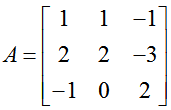
Solution Place the matrix in a new matrix with the 3 x 3 identity matrix to yield
We must use row operations to change the left side of the matrix to the identity matrix, one column at a time. In each column we’ll place a 1 in the appropriate position and then place zeros in the rest of the column.
For the first column, there is already 1 in the first row, first column. This means we can go straight to using row operations to put zeros in the rest of the first column.
To put a zero in the first column, second row, multiply the first row by -2 and add it to the second row. Place the sum in the second row. At the same time we add the first and third rows to put a zero in the first column, third row.
To place a 1 in the second row, second column, without changing the first column, interchange the second and third rows.
To complete the second column, a zero needs to be created in the first row second column. Multiply the second row by -1 and it to the first row. Place this sum in the first row.
The entry in the third row, third column must be changed to a 1 using row operations. Multiply the third row by -1 and place the result in the third row.
Two more row operations are needed to change the third column into the third column of the identity matrix.
The inverse matrix is the 3 x 3 matrix on the right side of this transformed matrix so
For some matrices, it is not possible to find an inverse. In the next example, we examine one of these matrices. Although the matrix is called B, the strategy is exactly the same as other examples.
Example 6 Find a Matrix Inverse
Find the inverse of the matrix 
Solution Place the matrix B in a new matrix next to a 2 x 2 identity matrix,
To change the entry in the first row, first column to a one, multiply the first row by 1/2.
Now add -3 times the first row and add it to the second row. Place the sum in the second row.
In carrying out the row operations to find the inverse, the second row in the left hand side of the matrix becomes zeros,
Because of these zeros, it is not possible to use row operations to change the left hand side of the matrix into the identity matrix. This means that the matrix B does not have an inverse.
In the next section, we’ll use the inverse of a matrix to solve systems of linear equations.




